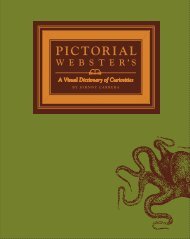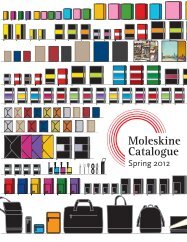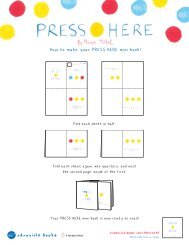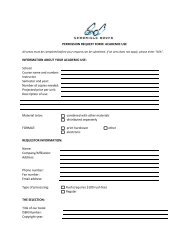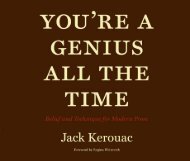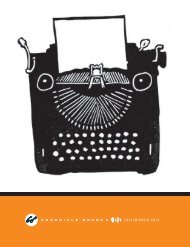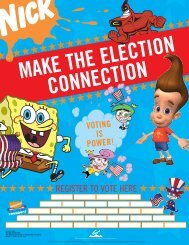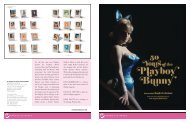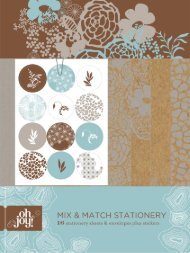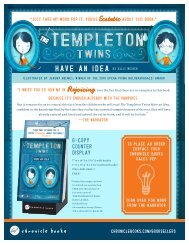Little Pea, Little Hoot, and Little Oink Teacher's Guide Grades K-2
Little Pea, Little Hoot, and Little Oink Teacher's Guide Grades K-2
Little Pea, Little Hoot, and Little Oink Teacher's Guide Grades K-2
- No tags were found...
Create successful ePaper yourself
Turn your PDF publications into a flip-book with our unique Google optimized e-Paper software.
THIS TEACHER’S GUIDE INCLUDES<br />
Pre-Planned Activities for Students<br />
• Language Arts<br />
• Science<br />
• Social Studies<br />
• Art<br />
<strong>Little</strong> <strong>Pea</strong>, <strong>Little</strong> <strong>Hoot</strong>, <strong>and</strong> <strong>Little</strong> <strong>Oink</strong><br />
Teacher’s <strong>Guide</strong> <strong>Grades</strong> K-2<br />
Dear Teacher:<br />
This trio of lively picture books will delight children with word play<br />
<strong>and</strong> concept inversion as the author st<strong>and</strong>s time-honored adult<br />
admonishments, such as “eat your vegetables,” on their heads! The<br />
clever texts provide opportunities for connections in language arts,<br />
science, social studies, <strong>and</strong> the arts. The books encourage critical<br />
thinking while simultaneously inspiring giggles in young readers.<br />
You’ll find activities for each individual book <strong>and</strong> activities for the<br />
three books as a series. Get ready for a delightful ride as you<br />
accompany <strong>Little</strong> <strong>Pea</strong>, <strong>Little</strong> <strong>Hoot</strong>, <strong>and</strong> <strong>Little</strong> <strong>Oink</strong> on their<br />
unexpected daily journeys.
The <strong>Little</strong> Books<br />
LANGUAGE ARTS<br />
Triple Bubble<br />
Begin by reading all three stories aloud to the class. Then, involve your students in a triple bubble activity by creating three<br />
very large overlapping circles on a chalk- or dry erase board, or on chart paper. Label each of the three circles as shown in<br />
the diagram below, taking care to make the three-way overlap rather large.<br />
<strong>Little</strong> <strong>Hoot</strong><br />
<strong>Little</strong> <strong>Pea</strong><br />
<strong>Little</strong> <strong>Oink</strong><br />
Use a variety of questions to elicit similarities<br />
<strong>and</strong> differences between the three books,<br />
such as:<br />
• Who are the characters in each book<br />
• What does each main character enjoy doing<br />
• What is the main character’s problem in each<br />
of the books<br />
• How are these problems similar How are these<br />
problems different<br />
• How are the main characters’ problems different<br />
from human children’s problems<br />
Write student responses in the appropriate sections<br />
of the diagram.<br />
Word Play<br />
Introduce the concept of “word play” (which is a clever exchange of words such as a pun which deliberately mixes two<br />
similar sounding words) to your students if they are unfamiliar with it. Author Amy Krouse Rosenthal ends each story with<br />
a clever bit of word play.<br />
Re-read each of the three stories <strong>and</strong> write the final line of each story on chart paper. Invite students to brainstorm other<br />
animals (or foods) that might star in a “<strong>Little</strong>” book. When you have exhausted student ideas, ask them to come up with<br />
final lines using the same pattern Rosenthal uses in her books:<br />
“And they owl lived happily ever after.”<br />
“And they all lived hap-pea-ly ever after.”<br />
“And they all lived hap-pig-ly ever after.”<br />
More “<strong>Little</strong>” Stories<br />
Each “<strong>Little</strong>” story is based on a family rule. After you have engaged students in the Animal Traits activity below, invite<br />
them to each choose another animal from the list <strong>and</strong> to write a “<strong>Little</strong>” story based on that animal. This can be an<br />
individual, paired, or group activity depending on the age of the students. Ask them to follow the patterns Rosenthal uses<br />
in all three of her stories <strong>and</strong> to invert the family rule.
SOCIAL STUDIES<br />
Family Rule Inversions<br />
All three of the “<strong>Little</strong>” books are based on inversions of typical family rules.<br />
After you read each book aloud, ask students to identify the three family rules that are being turned on their heads. Then,<br />
help students to create a declarative sentence following this pattern:<br />
In most families, the rule is: _________________________________________________________________, but in the<br />
_______ (pig, owl, pea) family, the rule is: _______________________________________________________________.<br />
Engage students in a group discussion of the bedtime, clean-up, <strong>and</strong> healthy eating rules in their families. Then, ask<br />
students to name other family rules for children. Create a list of these rules on chart paper.<br />
Discuss <strong>Little</strong> <strong>Hoot</strong>’s <strong>and</strong> <strong>Little</strong> <strong>Oink</strong>’s plans for rules for their own children when they grow up. Then, ask students which<br />
family rules they plan to change for their own children.<br />
SCIENCE<br />
Animal Traits<br />
Ask children to think more deeply about why Rosenthal’s inversions are especially funny. Why, for instance, is the messy<br />
room a perfect match for <strong>Little</strong> <strong>Oink</strong> Students will recognize that pigs are thought to be messy (i.e. rolling in mud).<br />
Often, we express these traits in similes. Read these similes aloud, filling in the missing animal as you go:<br />
wise as an __________<br />
happy as a __________ in mud<br />
busy as a __________<br />
slippery as an __________<br />
quick as a __________<br />
blind as a __________<br />
happy as a __________<br />
stubborn as a __________<br />
quiet as a __________<br />
gentle as a __________<br />
strong as an __________<br />
sick as a __________<br />
If you have time, invite students to talk to parents <strong>and</strong> other family members to gather additional similes.<br />
Next, create a chart that lists traits with animals said to possess them.<br />
Animal | Trait<br />
__________________|_________________<br />
|<br />
owl | wise<br />
pig | messy<br />
|<br />
Now, ask students to brainstorm family rules that would be logical for each animal family. For instance, drawing on the<br />
simile “as quick as a fox,” in a fox’s family, the rule might be “Eat as fast as you can,” whereas the human rule is to eat<br />
slowly, chewing thoroughly, <strong>and</strong> keeping your mouth closed. Because this is a challenging activity, it is perfect for Book<br />
Buddies where younger students can enlist the ideas of their older partners.
<strong>Little</strong> <strong>Pea</strong><br />
SCIENCE<br />
Eat Your C<strong>and</strong>y!<br />
Drawing from all food groups, invite students to brainstorm as many foods<br />
as they can think of (depending on the age of your students, you may need<br />
to put a time limit on the brainstorming session). Then, ask your students<br />
to classify this exhaustive list into several smaller lists. Make a chart of these<br />
lists using markers, <strong>and</strong> assign one marker color to each class of foods.<br />
Your classes might include:<br />
vegetables other healthy foods favorite c<strong>and</strong>ies<br />
other sweets<br />
junk foods<br />
Now, using small green circular stickers, ask students to come up to the chart, one at a time, <strong>and</strong> place a “pea” in front of<br />
each food that <strong>Little</strong> <strong>Pea</strong>’s parents would have made him eat before his dessert.<br />
<strong>Little</strong> <strong>Pea</strong>’s Pyramid<br />
Introduce students to the new Food <strong>Guide</strong> Pyramid from the United States Department of Agriculture at<br />
http://teamnutrition.usda.gov/Resources/mpk_poster.pdf. Discuss the food groups represented on the pyramid <strong>and</strong> why they<br />
are important for good health in humans.<br />
Instruct students to imagine <strong>and</strong> create the Food <strong>Guide</strong> Pyramid for <strong>Little</strong> <strong>Pea</strong> <strong>and</strong> his fellow young vegetables. What might<br />
it look like Which categories would it have <strong>and</strong> how much space would be devoted to each<br />
Know Your <strong>Pea</strong>s<br />
Introduce students to the many different kinds of peas by sharing pictures with them or bringing in samples to see <strong>and</strong><br />
taste, including:<br />
sugar-snap peas<br />
garden (or green) peas<br />
snow peas<br />
split peas<br />
You may also wish to bring in some chickpeas <strong>and</strong> black-eyed peas, which are actually not peas at all; they are beans.<br />
Once they are familiar with the different types of peas, ask students to identify which type of pea <strong>Little</strong> <strong>Pea</strong> is.<br />
Plant Your <strong>Pea</strong>s<br />
Some seed companies have begun to produce peas that can be grown in containers. Obtain a package of these seeds (such<br />
as <strong>Little</strong> Marvel <strong>Pea</strong> from ContainerSeeds.com) <strong>and</strong> grow pea plants in windowsill containers with your students. Chart<br />
weather (sunny days) <strong>and</strong> irrigation if desired.
<strong>Little</strong> <strong>Hoot</strong><br />
LANGUAGE ARTS<br />
Owlish Questions<br />
Each owl species makes its own sound. Begin by sharing several different owl calls with students using the sound files at<br />
http://www.owlpages.com/sounds.php. Choose one call that most sounds like the hooting sound that <strong>Little</strong> <strong>Hoot</strong> speaks in.<br />
Invite students to practice making an owl’s hoot.<br />
Now discuss the question words written above the chalkboard in <strong>Little</strong> <strong>Hoot</strong>’s classroom. All of them begin with the “wh”<br />
sound. Of course “who” sounds just like an owl’s call. Ask children to pronounce the other question words as <strong>Little</strong> <strong>Hoot</strong><br />
would if he were to pronounce them (with a full “hoo” sound at the beginning of each). Once they have practiced the<br />
pronunciations, challenge students to ask all of their questions all day using the owlish pronunciation of the question<br />
words.<br />
SCIENCE<br />
Nocturnal Means ‘At Night’<br />
Poor <strong>Little</strong> <strong>Hoot</strong>. All he wants is to go to sleep but his parents insist that he stay up late. Invite your students to explain why<br />
<strong>Little</strong> <strong>Hoot</strong>’s parents think staying up is a good idea. Once students all underst<strong>and</strong> that owls are nocturnal animals, invite<br />
them to explore books from the library about other nocturnal animals <strong>and</strong> then make a list of these animals (you can find<br />
extensive lists of nocturnal animals online if you would like to supplement their findings).<br />
Ask each student (or pair of students) to select a nocturnal animal. Supply each student with a sheet of paper large enough<br />
to accommodate a big illustration <strong>and</strong> one sentence. Ask students to illustrate their chosen animals in their nighttime<br />
environment <strong>and</strong> to write a sentence that reads:<br />
_____________ [animal name]________________________________[activity] at night.<br />
(e.g. Hedgehogs dig in the dirt for food at night.)<br />
Assemble student pages into a classroom book of nocturnal animals.<br />
ART<br />
Create an Owl<br />
Using the directions available at the Enchanted Learning Web site (http://www.enchantedlearning.com/crafts/animals/owl)<br />
guide students in making paper plate owls. If you have them available, glue feathers to the owls once they are colored<br />
<strong>and</strong> assembled.
<strong>Little</strong> <strong>Oink</strong><br />
ART CONNECTIONS<br />
National Pig Day Party<br />
Each year, on March 1, National Pig Day is celebrated. Plan a classroom or library celebration. In advance of the day, invite<br />
students to create pig masks using the template available at http://www.freefunfings.com/masks/masks/pdf/004008.pdf or<br />
using paper plates as the base.<br />
Read <strong>Little</strong> <strong>Oink</strong> aloud to your group of masked students <strong>and</strong> then enjoy a fine snack of pig slop (combine cookie crumbs,<br />
gummy worms, miniature marshmallows, <strong>and</strong>/or granola with pudding to make this delicious treat).<br />
SCIENCE<br />
What a Pigsty!<br />
Pigs are said to be dirty animals, but are they really Select one or more primary level nonfiction books or articles about<br />
pigs <strong>and</strong> share them with your students. Discuss where pigs’ dirty reputation comes from. What behavior makes people<br />
think they are messy<br />
Ask students to imagine that <strong>Little</strong> <strong>Oink</strong> has a chance to design his own pigsty. Using chart paper taped to the wall or laid<br />
out on an open area of the floor, draw a large, fenced-in pigpen. Invite students to illustrate the various areas that <strong>Little</strong><br />
<strong>Oink</strong> would include if he were living there.<br />
It Pays to Be Clean<br />
Even though the messy reputation of pigs might not be deserved in <strong>Little</strong> <strong>Oink</strong>, it makes the story a lot of fun. Invite<br />
students to imagine the classroom in its dirtiest, messiest state. Ask each student to imagine that he or she is <strong>Little</strong> <strong>Oink</strong><br />
<strong>and</strong> following Mama <strong>and</strong> Papa Pig’s instructions in the classroom. What would they dump out, spill, scatter, or leave lying<br />
around during “Mess Up Time”<br />
Now, discuss the consequences of each of those actions. Invite each student to compose a “consequences” statement.<br />
For example:<br />
If I spilled the paint all over the floor, someone might slip <strong>and</strong> fall.<br />
If I left my used tissue on the table, someone else might catch my cold.<br />
To reinforce the message, ask students to invert the statements.<br />
For example:<br />
I make sure not to spill paint on the floor so that no one slips <strong>and</strong> falls.<br />
I throw my used tissue in the trash so that no one catches my cold.
LANGUAGE ARTS<br />
<strong>Little</strong> <strong>Oink</strong> “Reader’s Theater”<br />
Read <strong>Little</strong> <strong>Oink</strong> aloud to children first, so that they can enjoy the illustrations <strong>and</strong> become familiar with the story. Then,<br />
h<strong>and</strong> out a set of photocopied scripts to nine students (for challenged readers to whom you’d like to assign brief parts with<br />
support, consider a part in the chorus). Ask the remaining children to be the audience or, alternatively, allow them to be a<br />
part of a large chorus. If you have plenty of time set aside, allow students to practice their parts individually or as a group<br />
until they are reading fluently. If time is limited, have performers face the audience <strong>and</strong> simply read their parts on the first<br />
run-through. Once all readers are comfortable with their parts, have a second reading with the opportunity to use props<br />
while reading. [Note: Each reader may want to wear a pig mask.]<br />
Roles<br />
Narrator One<br />
Narrator Two<br />
Narrator Three<br />
Chorus (three or more readers)<br />
Script<br />
<strong>Little</strong> <strong>Oink</strong><br />
Mama Pig<br />
Papa Pig<br />
Narrator One And now comes the story of<br />
<strong>Little</strong> <strong>Oink</strong>.<br />
Narrator Two <strong>Little</strong> <strong>Oink</strong> was a neat little pig.<br />
Narrator Three He liked a lot of things<br />
Narrator One He dug playing with his pig pals.<br />
<strong>Little</strong> <strong>Oink</strong> Hey, guys! I found a truffle!<br />
Narrator Two He savored his days at school.<br />
<strong>Little</strong> <strong>Oink</strong> Snort, grunt, squeal!<br />
Narrator Three And he relished nighttime with<br />
Mama Pig <strong>and</strong> Papa Pig.<br />
Mama Pig This little piggy went to market.<br />
This little piggy stayed home.<br />
This little piggy had roast beef.<br />
This little piggy had none.<br />
<strong>Little</strong> <strong>Oink</strong> And this little piggy ran allllllllll<br />
the way home.<br />
Narrator One But there was one thing <strong>Little</strong><br />
<strong>Oink</strong> did not like.<br />
Chorus Mess up time!<br />
Narrator Two Because that’s what you have<br />
to do when you’re a pig.<br />
Chorus Make a mess, mess, MESS!<br />
<strong>Little</strong> <strong>Oink</strong> All my friends get to clean<br />
their rooms. Why can’t I<br />
Papa Pig If you want to grow up to be a respectable<br />
pig, you must learn how to make a proper<br />
mess.<br />
Mama Pig Mess up your room, put on some dirty<br />
clothes, <strong>and</strong> then you can go out <strong>and</strong> play.<br />
<strong>Little</strong> <strong>Oink</strong> (snort) Do I have to<br />
Mama/Papa Pig Yes, you have to.<br />
Narrator Three So off he went.<br />
<strong>Little</strong> <strong>Oink</strong> (mutter) When I grow up, I’m going to let<br />
my kids clean up their rooms as much as<br />
they want.<br />
Narrator One He unmade his bed.<br />
Narrator Two He unfolded his clothes.<br />
Narrator Three He threw his towel on the floor.<br />
Narrator One He put on a stained T-shirt.<br />
Narrator Two He dragged in some mud.<br />
<strong>Little</strong> <strong>Oink</strong> Have I messed up enough<br />
Papa Pig I still see toys in their bin, mister.<br />
Mama Pig Please—not another word until this<br />
room’s a total pigsty.<br />
<strong>Little</strong> <strong>Oink</strong> (grunt) Fine.<br />
Chorus One toy. Two toys. Three toys. Four<br />
toys. Five toys. Six toys. Seven toys.<br />
Eight toys. Nine toys. Ten Toys. Zip,<br />
zoom, crash!<br />
<strong>Little</strong> <strong>Oink</strong> There. Now can I go play<br />
Papa Pig Yes, sweet swine of mine, now you can<br />
go play.<br />
Narrator Three And <strong>Little</strong> <strong>Oink</strong> ran off to play his most<br />
favorite game . . . house!<br />
Chorus Sweep. Scour. Scrub.<br />
<strong>Little</strong> <strong>Oink</strong> Now this is hog heaven!<br />
Chorus And they all lived hap-pig-ly ever after.
About the Author of this <strong>Guide</strong><br />
This guide was prepared by Toni Buzzeo, M.A., M.L.I.S.,<br />
educational consultant <strong>and</strong> library media specialist.<br />
About the Author<br />
Amy Krouse Rosenthal is a<br />
Chicago-based writer. She is<br />
the author of <strong>Little</strong> <strong>Pea</strong>,<br />
<strong>Little</strong> <strong>Hoot</strong>, <strong>Little</strong> <strong>Oink</strong>, Duck!<br />
Rabbit!, <strong>and</strong> several other<br />
books for children <strong>and</strong> adults.<br />
For more activities <strong>and</strong> information visit:<br />
chroniclebooks.com/littlebooks<br />
To request information on the author’s availability for<br />
events or to request promotional materials, please<br />
e-mail: kids@chroniclebooks.com<br />
CHRONICLEKIDS.COM


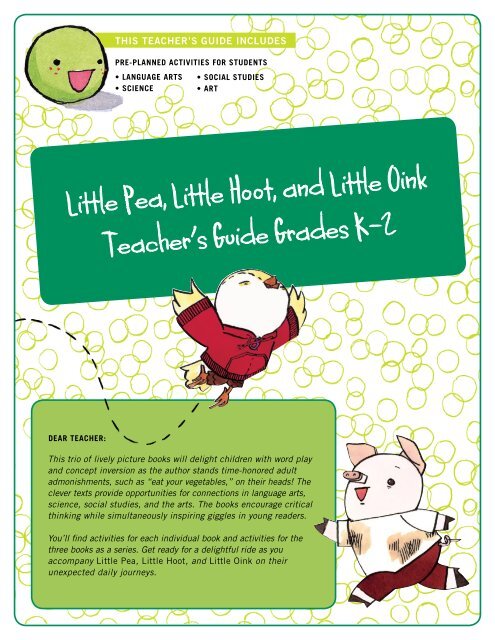
![I'm a Survivor! [pdf] - Chronicle Books](https://img.yumpu.com/48815452/1/185x260/im-a-survivor-pdf-chronicle-books.jpg?quality=85)

